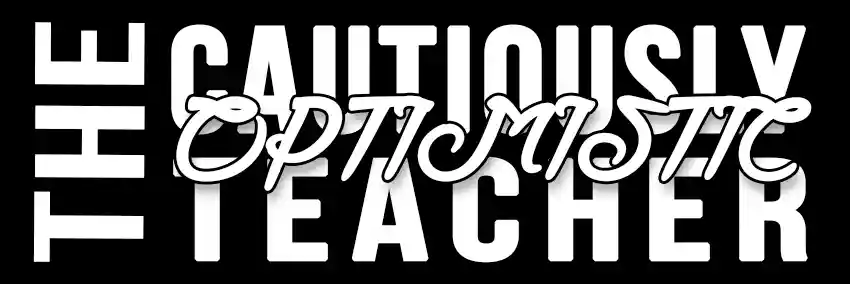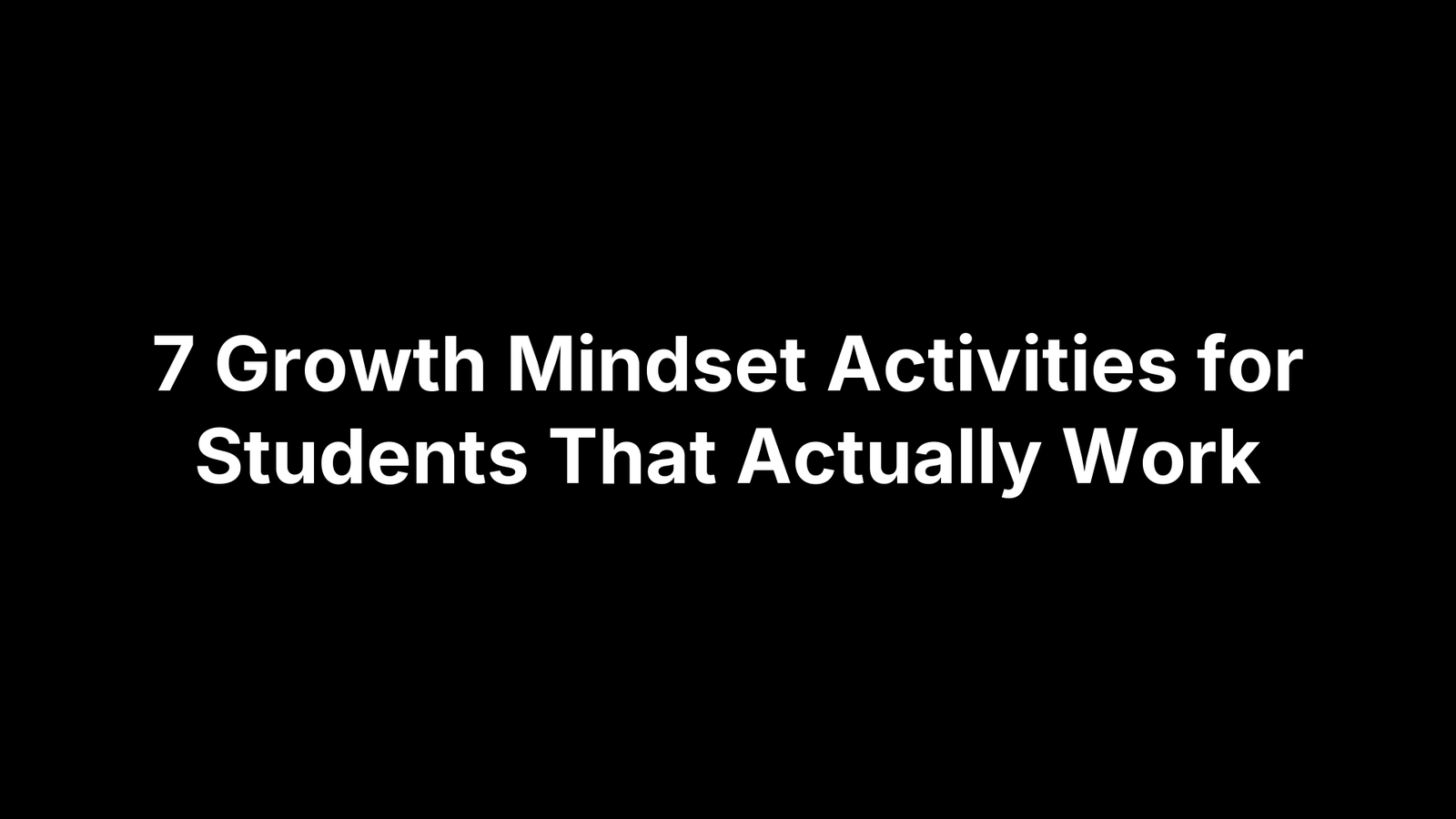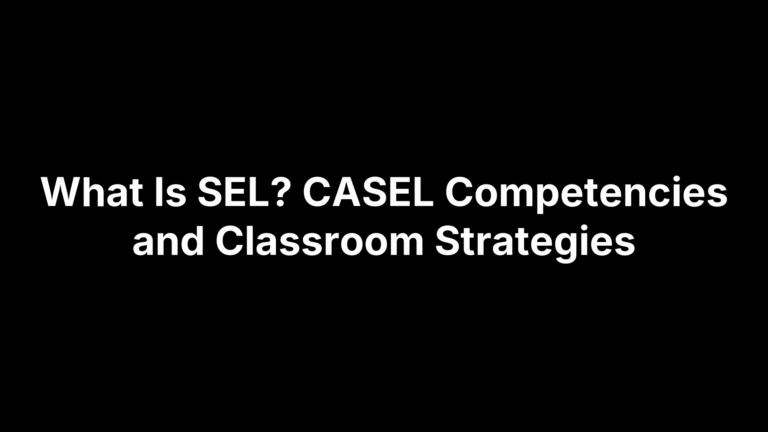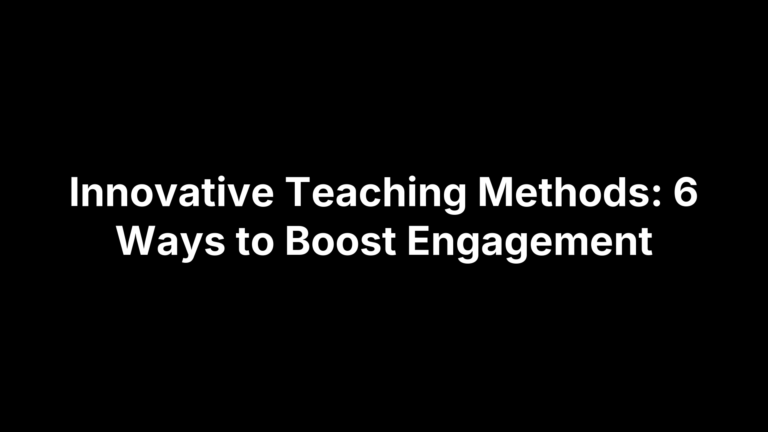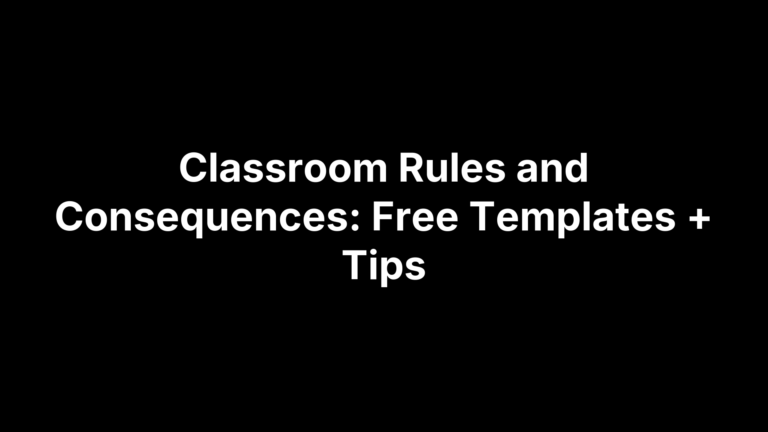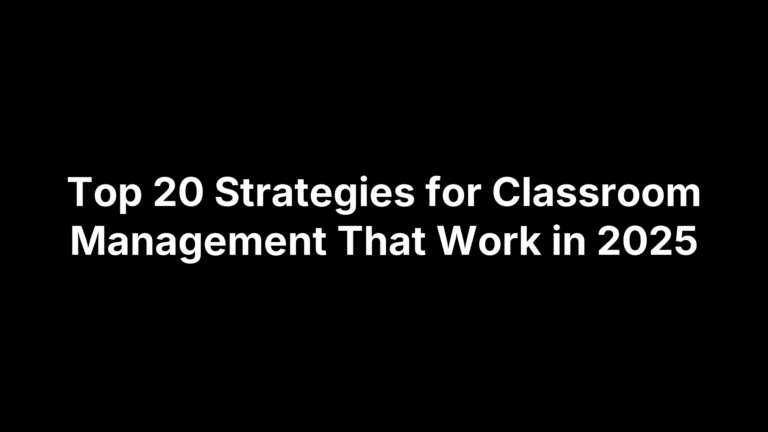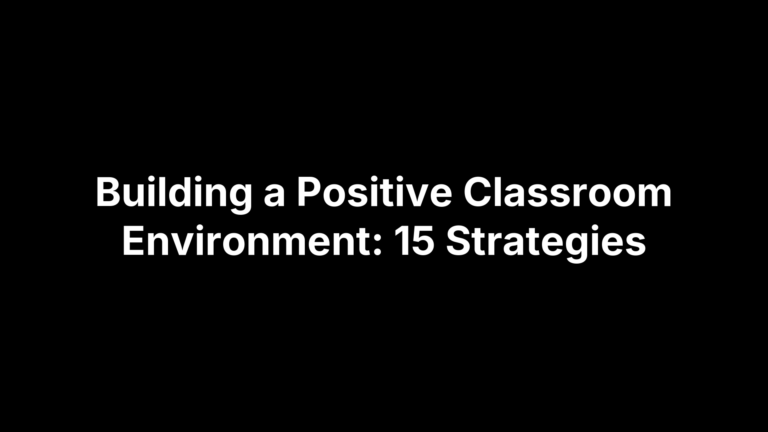7 Growth Mindset Activities for Students That Actually Work
If you’ve hung the posters and taught the vocabulary but still hear “I’m just bad at this,” you’re not alone. Many students understand growth mindset in theory yet default to perfectionism, avoidance, or “Is this graded?” when work gets tough. What’s missing is consistent, low-friction practice—short routines and clear protocols that normalize struggle, celebrate iteration, and make progress visible across subjects and grade levels without adding hours to your prep.
This guide shares seven classroom-tested growth mindset activities that actually stick. Each one includes what you’ll need, set-up and timing, step-by-step directions, differentiation ideas, and simple ways to assess and extend. From a daily Brain Builders warm-up and a class YET wall to a favorite mistake protocol, SMART sprints with habit trackers, a 3-try challenge, and a low-prep escape room, you’ll find quick wins you can run tomorrow and deeper projects for lasting habits. Ready to shift talk into action? Let’s start with an easy routine you can plug into any class period.
1. Use The Cautiously Optimistic Teacher’s Brain Builders Workshop routine
Think of Brain Builders as your five-to-eight–minute bell ringer for a growth mindset: a quick routine that blends micro-teaching about how the brain learns, short practice with productive struggle, and a fast reflection so students leave a breadcrumb trail of progress. Run it daily for two weeks, then two to three times per week to maintain momentum.
What you’ll need
Keep materials simple so you can launch this anywhere—ELA, math, science, electives—and keep prep low.
- Timer + display: Projector/board slide or sentence stems on chart paper.
- Student tool: Small notebook or one sheet stapled into a mini-journal.
- Prompt bank: “I used to think… Now I think…,” “One mistake I learned from…,” “Add ‘yet’ to this sentence…”
- Visibility aid: A small space on your wall or board to post class takeaways.
Set-up and timing
Post the day’s three-part agenda and stick to tight intervals so it stays crisp and repeatable.
- 2 min • Prime: One sentence about neuroplasticity or effort strategies.
- 3 min • Practice: A bite-size task with desirable difficulty.
- 2–3 min • Reflect: A written stem and one or two student shares.
Step-by-step
You’re coaching habits here, not grading products. Keep the tone warm, brisk, and curious.
- State the why: “We’re training our brains; mistakes are data.”
- Mini-teach (Prime): Share a quick truth (e.g., “Your brain forms new connections with effort.”).
- Launch the task (Practice): Give a just-right challenge from today’s content.
- Normalize struggle: Narrate strategies: “Try a second approach,” “Check an example,” “Ask a peer.”
- Reflect: Students complete
I used to think… Now I think…or addyetto a stuck statement. - Spotlight: Invite one 20-second share; post a class takeaway on the wall.
Differentiation ideas
A routine works when everyone can access it and still feel stretched. Adjust the entry points without removing the challenge.
- Scaffold language: Provide sentence frames and a visual word bank for “yet” swaps.
- Choice in output: Write, sketch, or speak-to-text for reflections.
- Tier the task: Offer Level A/B prompts that target the same skill with different complexity.
- Reduce pressure: Quiet hand signals or anonymous sticky shares for anxious students.
- Multilingual supports: Allow home-language drafting, then a quick English summary.
Assess and extend
Formative checks should be fast and authentic to the routine.
- Micro–exit ticket: Skim notebooks for one strategy named, not correctness.
- Trend spotting: Note common “stuck points” to plan tomorrow’s prime.
- Evidence wall: Compile weekly class takeaways into a “Progress We Can See” strip.
- Extend: Link reflections to your upcoming SMART sprint goals and habit trackers to make effort visible over time.
2. Change your words with a class YET wall and language swaps
Students’ self-talk shapes their effort. A visible YET wall plus daily language swaps trains them to reframe “I can’t” into “I can’t yet,” a hallmark of effective growth mindset activities for students. Keep it public, simple, and fast so the new language shows up during challenging work—not just on posters.
What you’ll need
- Space to post: Board section or chart paper.
- Sticky notes/index cards: Two colors (fixed vs. growth).
- Sentence stems: “I can’t…,” “This is too…,” “I don’t know how…”
- Swap bank: “yet,” “I’ll try another strategy,” “mistakes are data.”
Set-up and timing
- Launch (10 min): Model 3 common fixed statements and swap them live.
- Daily upkeep (2–3 min): Add one new swap during warm-up or closure.
- Weekly reset (5 min): Move “wins” to a “Now I Can” column.
Step-by-step
- Prime: Explain why words matter and introduce the power of “yet.”
- Model swaps: Transform three fixed statements; think aloud about strategies.
- Student add: Learners post one real “stuck” line; partner rewrites with a swap.
- Post and read: Add both notes to the wall; chorally read the growth versions.
- Spotlight use: Catch students using swaps during work time; add to the wall.
Differentiation ideas
- Provide frames: “I can’t ___ yet, but I will ___.”
- Multi-modal: Allow sketches or icons for early readers/ELs.
- Personalize: Students adopt one “go-to” swap on a desk tent.
- Quiet options: Anonymous submissions for shy or perfectionistic students.
Assess and extend
- Quick check: Listen for swap language during tasks; tally on a clipboard.
- Micro-reflection: Exit slip—write one fixed line you replaced today.
- Extend: Turn top class swaps into feedback stems you use in conferences.
3. Celebrate mistakes with a favorite mistake and fix-it protocol
When students see errors as clues instead of verdicts, they persist longer and learn faster. A weekly “favorite mistake” turns anonymous class misconceptions into teachable moments, then a short Fix-It protocol has every student practice diagnosing, correcting, and explaining—key moves in effective growth mindset activities for students.
What you’ll need
- Anonymous work sample: A common, instructive error (print or screenshot).
- Display tool: Projector/document camera or re-created sample on the board.
- Color cues: Two markers (e.g., red for error, green for fix).
- Fix-It form: Quick template with “What went wrong? How I fixed it. My strategy next time.”
- Norms slide: “We analyze work, not people.”
Set-up and timing
- Cadence: 1–2 times per week, mid-lesson or as a warm-up (10–12 minutes).
- Flow: 2 min prime • 4 min analyze • 3 min fix • 2–3 min reflect/share.
Step-by-step
- Prime the purpose: “Mistakes are data. Let’s learn from ours.”
- Show the sample: Read/solve it as written; avoid naming the author.
- Locate the fault line: Students annotate where thinking drifted and why.
- Model a fix: Think aloud one correct path; invite an alternative.
- Fix-It write: Students complete the form on their own similar item.
- Strategy share: Two 20-second shares; capture a class takeaway.
Differentiation ideas
- Provide stems: “The error was… because… Next time I will…”
- Tiered samples: Offer a partially correct version and a more complex one.
- Multi-modal: Allow sketches, color-coding, or manipulatives to explain fixes.
- Small-group clinics: Pull a quick huddle for students who share the same misconception.
- MLL supports: Side-by-side correct/incorrect exemplars with vocab visuals.
Assess and extend
- Glance grading: Check Fix-It forms for accurate diagnosis and a stated strategy.
- Misconception tracker: Tally recurring errors to plan mini-lessons.
- Mistake of the Week: Post the strategy, not the error, on your progress wall.
- Extend: Turn frequent fixes into a class “Error Library” students can consult during practice.
4. Research famous failures and create a success iceberg gallery
Students often think success is a straight line. This project flips that script by having them research “famous failures” and visualize what people don’t see—the grind beneath the win—using a Success Iceberg. It’s a high-impact addition to your growth mindset activities for students because it translates abstract resilience into concrete strategies they can copy.
What you’ll need
- Research access: Library books, vetted articles, or devices
- Iceberg template: Printed outline or blank paper
- Sticky notes/index cards: For unseen factors
- Display space: Wall, doors, or slide deck
- Rubric + reflection prompt: Process-focused
Set-up and timing
- Launch (8–10 min): Introduce “tip vs. base” of success
- Research (25–30 min): Pairs choose and study a figure
- Build (20 min): Create the iceberg visual
- Gallery walk (10–15 min): Silent tour + feedback dots
Step-by-step
- Hook: Show a quick win (headline) and ask, “What’s missing?”
- Model: Draw a simple iceberg; label tip “Outcome,” base “Effort, feedback, retries.”
- Choose a figure: Athletes, scientists, artists, entrepreneurs, authors.
- Research: Find at least three setbacks and three strategies used.
- Create: Tip = achievement; Base = bullets like “deliberate practice, mentors, learning from mistakes, time.”
- Gallery walk: Peers add one strategy they could steal this week.
Differentiation ideas
- Curated mini-bios for emerging readers/MLLs
- Choice board: Individuals, pairs, or triads; print or digital
- Sentence frames: “A setback was… They responded by…”
- Audio/visual option: 60-second voice note or sketchnote base
Assess and extend
- Process rubric: Credit quality of strategies over polish
- Exit reflection: “Which base strategy will I try next?”
- Strategy bank: Compile repeated bases into a class poster
- Bridge forward: Convert one “base” into a
SMARTsprint in the next activity
5. Make goals that stick with SMART sprints and habit trackers
Big goals inspire; small systems deliver. Turn mindset into motion with short SMART sprints and simple habit trackers so students can see effort compound. This pairs perfectly with other growth mindset activities for students because it makes progress visible and normalizes tiny, consistent wins.
What you’ll need
- SMART goal sheet: One clear, class-aligned target.
- Sprint card: Start/end date, checkpoints.
- Habit tracker: Monthly grid or 10-box “streak” ladder.
- Timer + routine: Daily one-minute check.
- Feedback stems: “What worked… What I’ll tweak…”
Set-up and timing
- Launch (12–15 min): Write one
SMARTgoal and pick 1–2 micro-habits. - Daily (2–3 min): Mark tracker + quick “because” reflection.
- Mid-sprint (5 min): Adjust a habit or cue.
- Finish (8–10 min): Review evidence and set the next sprint.
Step-by-step
- Choose a focus: Anchor to current content or a skill gap.
- Draft the goal: Use frames like “By [date], I will… so that… measured by…”.
- Pick micro-habits: Two actions ≤5 minutes each with a cue (e.g., “after bell, do 3 retrieval cards”).
- Plan friction fixes: Materials ready, peer check-ins, calendar reminders.
- Track daily: Check, color, or sticker; misses get a neutral dash.
- Review and reset: Circle evidence, name one effective strategy, roll it into the next sprint.
Differentiation ideas
- Provide menus: Ready-made habit ideas by subject.
- Language scaffolds: “I will ___ when ___ for ___ minutes.”
- Flexible trackers: Paper, digital, or icon-based for emerging readers.
- Right-size the load: One habit per day for students building stamina.
- Accountability pairs: Quiet partners or teacher check-ins.
Assess and extend
- Look for specificity: Goal aligns to standards and has a measure.
- Glance metrics: % of days tracked; note patterns, not perfection.
- 1-minute conference: “Keep–Tweak–Try” micro-feedback.
- Bridge routines: Start Brain Builders with a sprint update.
- Carry forward: Turn one winning habit into the class “strategy of the week.”
6. Try the 3-try challenge to practice iteration in any subject
Iteration beats perfection. The 3-try challenge gives students three short, timed attempts to improve the same task, making strategy use and progress visible fast. It works for sketches, sentences, proofs, code, and more—one of those growth mindset activities for students you can run any day in under 10 minutes.
What you’ll need
Keep materials light so you can deploy this on the fly.
- Timer + display: Tight caps keep focus.
- Clear, small task: E.g., “Draft a stronger claim,” “Sketch a cat,” “Refactor a loop.”
- Success criteria: 2–3 bullets students can aim for.
- 3-try strip: Space for
Try 1,Try 2,Try 3and a quick note. - Pens/markers: Optional different colors per try.
Set-up and timing
Frame it as practice through iteration, not a test. Keep the pace brisk.
- 1 min: Name the task and success criteria.
- 2 min: Try 1
- 2 min: Try 2 (after a 15-second strategy tip)
- 2 min: Try 3
- 1–2 min: Reflect and a couple of lightning shares
Step-by-step
Focus students on changing strategies, not just fixing surface errors.
- State the aim: “We’re improving with each try; perfection isn’t the goal.”
- Try 1: Work for two minutes; stop on the bell.
- Name a change: Write one tweak:
Next, I will… - Micro-tip: Offer a 15-second strategy (or peer share one).
- Try 2 → Try 3: Repeat the cycle; require a different tweak each time.
- Reflect:
Which change helped most and why?Capture a class takeaway.
Differentiation ideas
Adjust inputs so everyone can iterate meaningfully without lowering the bar.
- Frames: “My change was… It improved…”
- Modality choice: Write, sketch, speak-to-text, or annotate an exemplar.
- Leveled prompts: Same skill, varied complexity.
- Time flex: 90 seconds per try for beginners; 3 minutes for advanced.
Assess and extend
Assess the quality of changes, not the prettiness of the final product.
- Glance check: Look for specific, evolving tweaks across tries.
- Strategy tracker: Tally which strategies students use; plan next mini-lesson.
- Portfolio clip: Save a 3-try strip monthly to show growth.
- Bridge: Pair this with Favorite Mistake or SMART sprints to lock in winning tweaks.
7. Build perseverance with a low-prep classroom escape room
A classroom escape room turns struggle into a game: students collaborate, test ideas, and pivot when a path fails. It’s a perfect capstone for growth mindset activities for students—low prep, high energy, and built to reward perseverance over speed.
What you’ll need
Keep it simple by repurposing content you already teach.
- 3–4 envelope puzzles: Short, standards-aligned tasks that reveal codes or words.
- Paper “locks”: Codes, simple ciphers, or QR codes to a final clue slide.
- Visible timer: Projected countdown to add urgency.
- Facilitator map: One-page sequence of puzzles, answers, and hint notes.
- Debrief sheet: “What strategy did we try? Where did we pivot? What next?”
Set-up and timing
One period is plenty when you keep puzzles bite-size and the flow tight.
- 5 min: Brief + norms (collaboration, strategy shifts, respectful talk).
- 15–25 min: Escape play (teams rotate or work through envelopes).
- 5 min: Debrief (strategies, pivots, and one takeaway per team).
Step-by-step
Model persistence, then get out of the way and coach strategy.
- Set the mission: Theme + goal (e.g., “Crack three locks to launch the probe”).
- Establish norms: “Try three, then hint,” log attempts, celebrate near-misses.
- Start with Clue 1: Teams earn the next envelope with each correct solve.
- Run a hint economy: 1 free hint; extra hints cost 30 seconds (optional).
- Spotlight strategy: Pause once to name a useful move you see.
- Debrief: Each team shares one stuck point, one pivot, one strategy to keep.
Differentiation ideas
- Tiered puzzles: Color-code A/B versions targeting the same standard.
- Role cards: Reader, checker, skeptic, timekeeper to balance voices.
- Language supports: Sentence frames, visuals, word banks for MLLs.
- Mini-room option: Solo/pair envelopes at desks for anxious learners.
- Access tools: Large print, manipulatives, or calculators as needed.
Assess and extend
- Observe for mindset: Tally strategy use and collaboration—not finish time.
- Collect logs: Review attempts, hints used, and noted pivots.
- Exit slip: “What will you try first next time you’re stuck—and why?”
- Extend: Turn the trickiest puzzle into a Favorite Mistake, or have students design the next mini-escape aligned to your current unit.
Keep the mindset momentum going
Growth mindset sticks when it lives in your routines, not just your posters. Pick one activity to launch tomorrow, calendar it, and keep it short and repeatable. Then stack a second habit (a weekly Favorite Mistake or 3-Try Challenge), and keep evidence visible with your YET wall, sprint trackers, and class takeaways. Praise the process, name strategies out loud, and let students own the language and the data—little wins snowball.
Want ready-to-use prompts, planning templates, and tools to streamline all of this? Explore more resources and teacher-first AI helpers at The Cautiously Optimistic Teacher. Keep it simple, consistent, and public—and watch your students’ talk turn into tenacity.
